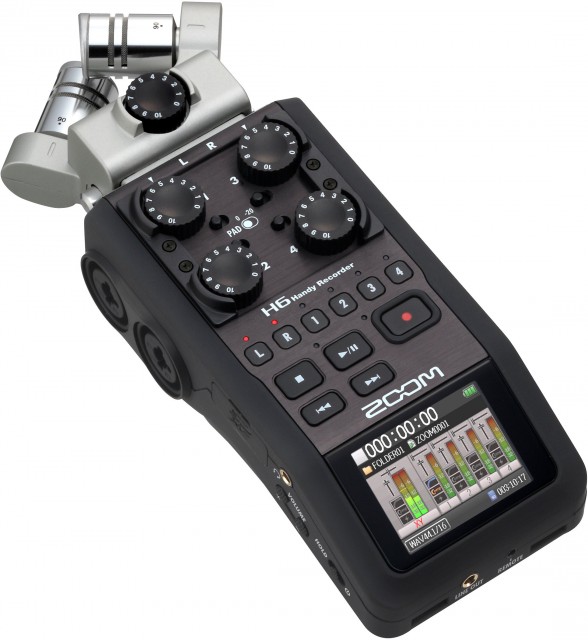
Zoom’s new handheld H6 has an ecosystem of stuff to match, making it more adaptable to shooting with an SLR or using it as a musician. It even works with furballs, pictured top left. 😉 Photos courtesy Zoom.
Zoom has done a lot to popularize field recording, but perhaps equally impressive is how its products have improved. The first H4, for instance, earned the name “handy” recorder, but it was the successor H4N that finally provided dedicated controls, a body that better handled noise and that felt more professional, that didn’t require diving into menus just to set level.
Some of the video recording options reverted to more annoyances – I was once in a cab in Philadelphia in which the driver volunteered that he couldn’t stand the Q3’s interface because he couldn’t properly set levels for his heavy metal band. But in the age of ever-more-brilliant dedicated cameras, and affordable iPhones for everything else, it’s really the dedicated audio recorder that you want.
And the Zoom H6, which started shipping in August, looks like a serious contender. Zoom has continued the steady maturation of the H-series, and placed the H6 at the center of an ecosystem of accessories that adapt it to different situations. After all, even one user might fit in several categories – you want to record a DJ mix, but also shoot some interviews for fans on your Website. You’re recording your chamber quartet, but also documenting a lecture. You’re making a short film, but also doing field recordings for the soundtrack and recording a podcast for the Kickstarter campaign. (I’ll stop.)

The shotgun capsule started shipping this week. Zoom suggests switching capsules like switching lenses – smart, as they market this as videographers and musicians alike.
The H6 fits all our moonlighting. 400 bucks gets the H6, interchangeable X/Y and Mid/Side capsules for stereo recording, a carry case, a 2 GB memory card, and, in case there’s any doubt this is for audio use, too, even a copy of Cubase LE. (You don’t even need to buy the four AA batteries.)
And, as you see in the pics here, there’s a good chance you’ll put the H6 atop a DSLR, the way most of us film these days when not just grabbing quick iPhone shots. (Actually, a DSLR coupled with an H6 has a head start on smartphones for some time to come. Look at the size of the lens, the sensor, and the mics; good as the iPhone 5S is, the laws of physics aren’t going anywhere. The good news is, you can still afford the camera and H6 – even if you blew your budget buying a Galaxy or iPhone out of contract.)

A combination it seems likely we’ll be seeing, particularly with the addition of the shotgun capsule for interviews.
That’s the start of the H6. This week, at the audio trade show AES in New York, Zoom North America announced they’re shipping the shotgun mic capsule – ideal for handheld SLR interviews. We’re still waiting on the dual XLR/TRS combo capsules for four additional jacks if you need more channels; but for now, you get the two jacks already on the device.
And there are other features for specific applications:
- Videographers: Line Out connects to a camera.
- Broadcast: BWF WAV support, and up to 24-bit / 96k (the latter I think mainly of interest if you’re doing significant processing afterward).
- Musicians wanting to practie: A metronome, a chromatic tuner, and – in features some of us miss from cassette tape days, playback speed (now with pitch correction).
- The nervous: Auto-record, backup-record.
For everyone, there’s USB connectivity.
For US$129.99, you can add the Shotgun Capsule (that’s SGH-6, if you care). Highly directional, Zoom says they have used internal DSP and three mic elements to mimic the pickup behavior of a shotgun twice as big – so you can tote this around easily and connect it to your camera and so on.
In fact, Zoom uses cameras as the metaphor, suggesting you’d swap capsules just as you’d swap lenses.
The combination definitely looks powerful. I hope we get to do a proper video test; this looks like formidable competition, especially at the price.
And to determine whether this is good enough for jazz, Zoom has a video they’ve done with legendary drummer/composer Peter Erskine. It was all shot on the X/Y capsule, plus spot mics plugged into the H6 pre’s. (Nice, though of course you’d want to try this in more different scenarios in the field.)
